Manalapan
(732) 845-0100
Manalapan (732) 845-0100

The feet, being the foundation of the body, carry all of the body’s weight and are therefore prone to experiencing pain and discomfort. If you are experiencing foot pain, it is important to determine where in the foot you are experiencing this pain to help discover the cause of it. While pain can be experienced virtually anywhere in the foot, the most common sites of foot pain are in the heel and ankle.
Heel pain can be due to a multitude of conditions including plantar fasciitis, Achilles tendinitis, and heel spurs. Pain experienced in the ankle can be a sign of an ankle sprain, arthritis, gout, ankle instability, ankle fracture, or nerve compression. In more serious cases, pain in the foot can be a sign of improper alignment or an infection.
Foot pain can be accompanied by symptoms including redness, swelling, stiffness and warmth in the affected area. Whether the pain can be described as sharp or dull depends on the foot condition behind it. It is important to visit your local podiatrist if your foot pain and its accompanying symptoms persist and do not improve over time.
Depending on the location and condition of your foot pain, your podiatrist may prescribe certain treatments. These treatments can include but are not limited to prescription or over-the-counter drugs and medications, certain therapies, cortisone injections, or surgery.
If you are experiencing persistent foot pain, it is important to consult with your foot and ankle doctor to determine the cause and location. He or she will then prescribe the best treatment for you. While milder cases of foot pain may respond well to rest and at-home treatments, more serious cases may take some time to fully recover.
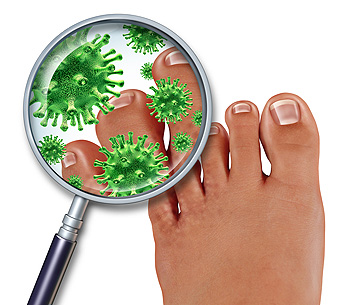 The fungus that is known as athlete’s foot typically thrives in warm and moist places. The skin on the feet may be a desired environment for this type of fungus to live, and that may be a result of wearing shoes and socks for the majority of the day. It generally lives between the toes, and the symptoms include itchiness, redness, and flaky skin. Additionally, this type of fungus may be found on public shower room floors, locker rooms, and other contaminated surfaces. If you frequent these types of places, it is suggested that appropriate shoes are worn, and this may aid in preventing the fungus from entering the skin. If a mild case of athlete’s foot is experienced, over the counter treatments may be successful in treating this condition. If you have pain and discomfort originating from this ailment, it is suggested to speak to a podiatrist who can offer proper treatment techniques.
The fungus that is known as athlete’s foot typically thrives in warm and moist places. The skin on the feet may be a desired environment for this type of fungus to live, and that may be a result of wearing shoes and socks for the majority of the day. It generally lives between the toes, and the symptoms include itchiness, redness, and flaky skin. Additionally, this type of fungus may be found on public shower room floors, locker rooms, and other contaminated surfaces. If you frequent these types of places, it is suggested that appropriate shoes are worn, and this may aid in preventing the fungus from entering the skin. If a mild case of athlete’s foot is experienced, over the counter treatments may be successful in treating this condition. If you have pain and discomfort originating from this ailment, it is suggested to speak to a podiatrist who can offer proper treatment techniques.
Athlete’s foot is an inconvenient condition that can be easily reduced with the proper treatment. If you have any concerns about your feet and ankles, contact Dr. Charles Marchese from Manalapan Foot & Ankle. Our doctor will treat your foot and ankle needs.
Athlete’s Foot: The Sole Story
Athlete's foot, also known as tinea pedis, can be an extremely contagious foot infection. It is commonly contracted in public changing areas and bathrooms, dormitory style living quarters, around locker rooms and public swimming pools, or anywhere your feet often come into contact with other people.
Solutions to Combat Athlete’s Foot
Athlete’s foot can cause many irritating symptoms such as dry and flaking skin, itching, and redness. Some more severe symptoms can include bleeding and cracked skin, intense itching and burning, and even pain when walking. In the worst cases, Athlete’s foot can cause blistering as well. Speak to your podiatrist for a better understanding of the different causes of Athlete’s foot, as well as help in determining which treatment options are best for you.
If you have any questions please feel free to contact our office located in Manalapan, NJ . We offer the newest diagnostic and treatment technologies for all your foot and ankle needs.
Athlete’s foot is a type of fungal infection that affects the skin on the feet. It is caused when the tinea fungus grows on the foot. It is possible to catch the fungus through direct contact with someone who has it or by touching a surface that is contaminated with it. This type of fungus thrives in warm, moist environments such as showers, locker room floors, and swimming pools. Your risk of getting it may also increase by wearing tight-fitting, closed-toe shoes, or by having sweaty feet.
Symptoms of athlete’s foot include itching, stinging or burning sensations between the toes. You may also experience toenails that are discolored, thick, crumbly, or toenails that pull away from the nail bed.
Your podiatrist may diagnose athlete’s foot by detecting these symptoms or by doing a skin test to see if there is a fungal infection present. The most common exam used to detect Athlete’s foot is a skin lesion potassium hydroxide exam. To use this method, your doctor will scrape off a small area of the infected skin and place it into potassium hydroxide. The potassium hydroxide will destroy the normal cells and leave the fungal cells untouched so that they are visible under a microscope.
There are a variety of treatment options for athlete’s foot. Some medications are miconazole (Desenex), terbinafine (Lamisil AT), clotrimazole (Lotrimin AF), butenafine (Lotrimin Ultra), and tolnaftate (Tinactin). While these options may be able to treat your fungus, it is best that you consult with a podiatrist in order to see which treatment option may work best for you.
In some cases, Athlete’s foot may lead to complications. A severe complication would be a secondary bacterial infection which may cause your foot to become swollen, painful, and hot.
There are ways that you can prevent athlete’s foot. Washing your feet with soap and water each day and drying them thoroughly is an effective way to prevent infections. You also shouldn’t share socks, shoes, or towels with other people. It is crucial that you wear shower sandals in public showers, around swimming pools, and in other public places. Additionally, you should make sure you wear shoes that can breathe and change your socks when your feet become sweaty. If you suspect that you have Athlete’s foot, you should seek help from a podiatrist as soon as possible.
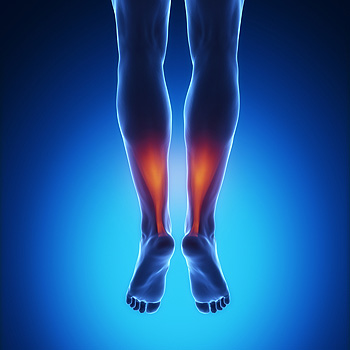 The largest tendon in the body is referred to as the Achilles tendon. It is located in the back of the calf, and it’s function is to connect the lower leg to the heel of the foot. Most tendons have the ability to stretch, and inflammation may occur if this tendon is overstretched. If this should occur, a tear may develop, and this condition is known as Achilles tendonitis. There are several noticeable signs that are associated with this ailment, specifically when the foot is bent in a downward position, including extreme tenderness, severe pain and discomfort. Additionally, the affected area may be stiff and difficult to bend upon arising in the morning. Many athletes may be affected by this condition, especially if their chosen sport involves frequent stopping and starting activities. If you feel you have injured your Achilles tendon, it is advised to speak to a podiatrist who can properly diagnosis and treat this uncomfortable condition.
The largest tendon in the body is referred to as the Achilles tendon. It is located in the back of the calf, and it’s function is to connect the lower leg to the heel of the foot. Most tendons have the ability to stretch, and inflammation may occur if this tendon is overstretched. If this should occur, a tear may develop, and this condition is known as Achilles tendonitis. There are several noticeable signs that are associated with this ailment, specifically when the foot is bent in a downward position, including extreme tenderness, severe pain and discomfort. Additionally, the affected area may be stiff and difficult to bend upon arising in the morning. Many athletes may be affected by this condition, especially if their chosen sport involves frequent stopping and starting activities. If you feel you have injured your Achilles tendon, it is advised to speak to a podiatrist who can properly diagnosis and treat this uncomfortable condition.
Achilles tendon injuries need immediate attention to avoid future complications. If you have any concerns, contact Dr. Charles Marchese of Manalapan Foot & Ankle. Our doctor can provide the care you need to keep you pain-free and on your feet.
What Is the Achilles Tendon?
The Achilles tendon is a tendon that connects the lower leg muscles and calf to the heel of the foot. It is the strongest tendon in the human body and is essential for making movement possible. Because this tendon is such an integral part of the body, any injuries to it can create immense difficulties and should immediately be presented to a doctor.
What Are the Symptoms of an Achilles Tendon Injury?
There are various types of injuries that can affect the Achilles tendon. The two most common injuries are Achilles tendinitis and ruptures of the tendon.
Achilles Tendinitis Symptoms
Rupture Symptoms
Treatment and Prevention
Achilles tendon injuries are diagnosed by a thorough physical evaluation, which can include an MRI. Treatment involves rest, physical therapy, and in some cases, surgery. However, various preventative measures can be taken to avoid these injuries, such as:
If you have any questions please feel free to contact our office located in Manalapan, NJ . We offer the newest diagnostic tools and technology to treat your foot and ankle needs.
The Achilles tendon is the strongest tendon in the human body. Its purpose is to connect the lower leg muscles and calf to the heel of the foot. This tendon is responsible for facilitating all types of movement, like walking and running. This tendon provides an enormous amount of mobility for the body. Any injuries inflicted to this tissue should be immediately brought up with a physician to prevent further damage.
The most common injuries that can trouble the Achilles tendon are tendon ruptures and Achilles tendinitis. Achilles tendinitis is the milder of the two injuries. It can be recognized by the following symptoms: inflammation, dull-to-severe pain, increased blood flow to the tendon, thickening of the tendon, and slower movement time. Tendinitis can be treated via several methods and is often diagnosed by an MRI.
An Achilles tendon rupture is trickier to heal, and is by far the most painful injury. It is caused by the tendon ripping or completely snapping. The results are immediate and absolutely devastating, and will render the patient immobile. If a rupture or tear occurs, operative and non-operative methods are available. Once the treatment begins, depending on the severity of the injury, recovery time for these types of issues can take up to a year.
Simple preventative measures can be taken as a means to avoid both injuries. Prior to any movement, taking a few minutes to stretch out the tendon is a great way to stimulate the tissue. Calf raises, squats, leg curls, leg extensions, leg raises, lunges, and leg presses are all suggested ways to help strengthen the lower legs and promote Achilles tendon health.
Many problems arise among athletes and people who overexert themselves while exercising. Problems can also happen among those who do not warm up properly before beginning an activity. Proper, comfortable shoes that fit correctly can also decrease tendon injuries. Some professionals also suggest that when exercising, you should make sure that the floor you are on is cushioned or has a mat. This will relieve pressure on the heels. A healthy diet will also increase tendon health.
It is very important to seek out a podiatrist if you believe you have an injury in the Achilles region. Further damage could result in severe complications that would make being mobile difficult, if not impossible.
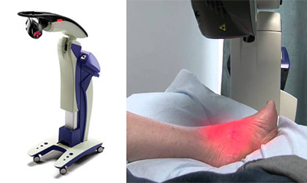 Patients who endure chronic foot pain as a result of plantar fasciitis or tendonitis may be interested in engaging in shockwave therapy as a possible treatment option. This type of treatment is known to be effective in bringing upon a healing response which can precede the repair process. There are generally two types of this type of therapy, and these are referred to as low and high energy treatments. The treatment is performed in three or more sessions, and typically causes little or no pain. The latter may require anesthesia which may be effective in blocking any pain that may come from this one-time treatment method. There are known to be benefits in addition to disadvantages if this type of treatment is chosen, and it is strongly suggested to consult with a podiatrist who can determine if this is correct for you
Patients who endure chronic foot pain as a result of plantar fasciitis or tendonitis may be interested in engaging in shockwave therapy as a possible treatment option. This type of treatment is known to be effective in bringing upon a healing response which can precede the repair process. There are generally two types of this type of therapy, and these are referred to as low and high energy treatments. The treatment is performed in three or more sessions, and typically causes little or no pain. The latter may require anesthesia which may be effective in blocking any pain that may come from this one-time treatment method. There are known to be benefits in addition to disadvantages if this type of treatment is chosen, and it is strongly suggested to consult with a podiatrist who can determine if this is correct for you
Shockwave therapy is a treatment commonly used to treat various injuries and conditions, particularly plantar fasciitis in the feet. To learn more, consult with Dr. Charles Marchese from Manalapan Foot & Ankle. Our doctor can provide the care you need to keep you pain-free and on your feet.
Shockwave Therapy
Shockwave therapy is a new treatment option designed to treat bone conditions such as tennis elbow, shoulder pain, and others. Shockwave therapy uses high intensity sound waves that are directed to the affected tissues of the body with pinpoint accuracy. The effects are very beneficial, leading to a production of collagen fibers, eliminating inflammation.
Who Benefits from Shockwave?
Shockwave is recommended for patients suffering from heel pain and associated problems. Heel pain is a common condition which can be caused by obesity, overexertion, and spending a substantial amount of time on hard floors with your feet exposed and unsupported.
Fast and Easy
The therapy is actually a simple process that can leave patients feeling better the very next day. Shockwave therapy is not as dramatic as it sounds. It enables more blood flow to effected areas, addressing the source of the problem and allowing treatment to last for a long time.
Treatment & Recovery Time
Shockwave treatment will enable your feet to recover quickly. This is especially important since surgery is not required. It is cost effective and does not require the use of anesthesia. This treatment is a better option to surgery, since it is proven safe.
If you have any questions, please feel free to contact our office located in Manalapan, NJ . We offer the newest diagnostic and treatment technologies for all your foot and ankle needs.
Extracorporeal Shockwave Therapy (ESWT) is an alternative treatment method that is used for bone and soft tissue disorders in the foot and ankle. EWST is a noninvasive option for pain relief and it was originally created to help dissolve kidney stones. This therapy works by focusing impulses to target the area in pain. This method has been proven to show a reduction in the amount of nerve fibers that transmit painful impulses, which leads to a reduction in pain. Shockwave therapy can also expedite the tissue which would, in turn, increase the amount of new blood vessels that are formed.
Conditions that can be treated with shockwave therapy include Achilles pain and heel pain. People with plantar fasciitis may opt for this therapy and the results are usually great after 18 months. Additionally, this method can also be used to treat fractures that have failed to heal correctly. Anesthesia is not required to perform this treatment. It usually is not painful, but it can be uncomfortable.
The duration of treatment sessions usually lasts 5-15 minutes each. This procedure is safe since there is no risk of infection from wound complications, if you are looking to try shockwave therapy to heal plantar fasciitis, it may take 3-4 sessions to start working. After treatment, patients typically notice a dull pain in the area which was treated. However, this pain rarely lasts more than 24 hours.
Nevertheless, there are pros and cons that come along with Shockwave Therapy. The most obvious pro is that this treatment is noninvasive, meaning surgery will not be required. Another upside is that there have been very little complications that have been found with this procedure. On the other hand, those who opt for surgery are at risk for continued pain, wound problems, and infections. The biggest con for ESWT is that it is very expensive; it typically costs around $1,000 before insurance. Another con is that the effectiveness of the treatment is questionable. Usually, if this treatment is helpful, the difference is small.
If you are curious about Shockwave Therapy, you should talk to your podiatrist to see if this treatment method is right for you. At times, patients will find that there are other treatment options that are more efficient for their individual cases.
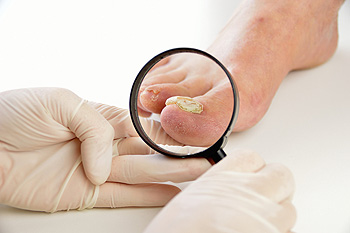 The toenail infection that is known as onychomycosis, or toenail fungus, will most likely not disappear on its own. The possibility of the nail bed becoming infected, which may gradually destroy the toenails, may increase unless this type of fungus is properly treated. Research has shown there may be effective ways that can be implemented, which may prevent toenail fungus. These may include washing and thoroughly drying your feet before wearing shoes, trimming the toenails straight across, which may aid in preventing the nail to grow past the top of the toe, and wearing appropriate shoes in public showers, pools, and surrounding areas. Possible treatments for this unsightly foot condition may include using specific medications in addition to surgically removing a portion of the nail. If you see the beginning stages of toenail fungus, it is advised to consult with a podiatrist who can properly diagnose and treat this condition.
The toenail infection that is known as onychomycosis, or toenail fungus, will most likely not disappear on its own. The possibility of the nail bed becoming infected, which may gradually destroy the toenails, may increase unless this type of fungus is properly treated. Research has shown there may be effective ways that can be implemented, which may prevent toenail fungus. These may include washing and thoroughly drying your feet before wearing shoes, trimming the toenails straight across, which may aid in preventing the nail to grow past the top of the toe, and wearing appropriate shoes in public showers, pools, and surrounding areas. Possible treatments for this unsightly foot condition may include using specific medications in addition to surgically removing a portion of the nail. If you see the beginning stages of toenail fungus, it is advised to consult with a podiatrist who can properly diagnose and treat this condition.
For more information about treatment, contact Dr. Charles Marchese of Manalapan Foot & Ankle. Our doctor can provide the care you need to keep you pain-free and on your feet.
Toenail Fungus Treatment
Toenail fungus is a condition that affects many people and can be especially hard to get rid of. Fortunately, there are several methods to go about treating and avoiding it.
Antifungals & Deterrence
Oral antifungal medicine has been shown to be effective in many cases. It is important to consult with a podiatrist to determine the proper regiment for you, or potentially explore other options.
Applying foot powder on the feet and shoes helps keep the feet free of moisture and sweat.
Sandals or open toed shoes – Wearing these will allow air movement and help keep feet dry. They also expose your feet to light, which fungus cannot tolerate. Socks with moisture wicking material also help as well.
If you have any questions please feel free to contact our office located in Manalapan, NJ . We offer the newest diagnostic tools and technology to treat your foot and ankle needs.
Fungal infection of the toenail, or onychomycosis, typically appears as a gradual change in a toenail’s texture and color that involves brittleness and darkening. The fungal infection itself occurs beneath the surface of the nail. Aside from discoloration, other symptoms include the collection of debris beneath the nail plate, white marks on the nail plate, and a foul odor emanating from the nail. If ignored, the infection can spread into other nails and the skin; in severe cases, it can hinder one’s ability to work or walk.
The toenails are particularly vulnerable to contracting infection in moist environments where people are likely to be walking barefoot, such as around swimming pools, public showers, and locker rooms. Fungal infection may also be more likely to occur in nail beds that have been injured, and sufferers of chronic diseases such as diabetes, circulatory problems, or immunodeficiency conditions are particularly prone to developing fungal nails.
Fungal nails can be primarily prevented by practicing proper hygiene and regularly examining the feet and toes. Carefully washing the feet with soap and water and thoroughly drying the feet afterwards are essential. Other tips include wearing shower shoes in public areas, changing shoes and socks daily, keeping toenails clipped at a short length, wearing breathable shoes that fit properly, wearing moisture-wicking socks, and disinfecting home pedicure tools and instruments used to cut nails.
Fungal nail treatment may vary between patients and the severity of the condition. Your podiatrist may suggest a daily routine of cleansing that spans over a period of time to ease mild infections. Over-the-counter or prescription antifungal agents may also be prescribed, including topical and/or oral medications. Debridement, or the removal of diseased nail matter and debris, may also be performed. In more severe cases, surgical treatment may be needed. In some instances, the temporary removal of the fungal nail allows for the direct application of a topical antifungal to the nail bed. In other cases, a chronically painful fungal nail that has not responded to other treatments may be permanently removed; this allows the infection to be cured and avoids the growth of a deformed nail.
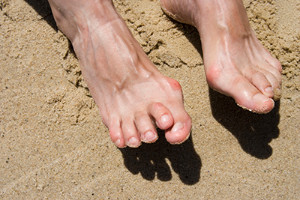 The medical condition that is referred to as hammertoe has been known to originate from wearing shoes that fit incorrectly. This type of shoe may include high heels, as they force the toes to be cramped into a space that may have inadequate room to move about in. The toes may bend downward at the middle joint, and this may resemble a hammer. There may be additional conditions that may develop as a result of hammertoe, which may often include blisters or bunions. Some patients may find moderate relief in wearing insoles in their shoes, in addition to gently stretching the toes, which may be beneficial in reducing pain and discomfort. In severe cases, the most effective treatment may be to undergo surgery, in which the toes can be straightened out. If you feel you are at the beginning stages of developing hammertoe, it is suggested that you seek the counsel of a podiatrist so correct treatment options can be discussed.
The medical condition that is referred to as hammertoe has been known to originate from wearing shoes that fit incorrectly. This type of shoe may include high heels, as they force the toes to be cramped into a space that may have inadequate room to move about in. The toes may bend downward at the middle joint, and this may resemble a hammer. There may be additional conditions that may develop as a result of hammertoe, which may often include blisters or bunions. Some patients may find moderate relief in wearing insoles in their shoes, in addition to gently stretching the toes, which may be beneficial in reducing pain and discomfort. In severe cases, the most effective treatment may be to undergo surgery, in which the toes can be straightened out. If you feel you are at the beginning stages of developing hammertoe, it is suggested that you seek the counsel of a podiatrist so correct treatment options can be discussed.
Hammertoes can be a painful condition to live with. For more information, contact Dr. Charles Marchese of Manalapan Foot & Ankle. Our doctor will answer any of your foot- and ankle-related questions.
Hammertoe
Hammertoe is a foot deformity that occurs due to an imbalance in the muscles, tendons, or ligaments that normally hold the toe straight. It can be caused by the type of shoes you wear, your foot structure, trauma, and certain disease processes.
Symptoms
Risk Factors
Treatment
If you have hammertoe, you should change into a more comfortable shoe that provides enough room for your toes. Exercises such as picking up marbles may strengthen and stretch your toe muscles. Nevertheless, it is important to seek assistance from a podiatrist in order to determine the severity of your hammertoe and see which treatment option will work best for you.
If you have any questions, please feel free to contact our office located in Manalapan, NJ . We offer the newest diagnostic and treatment technologies for all your foot care needs.